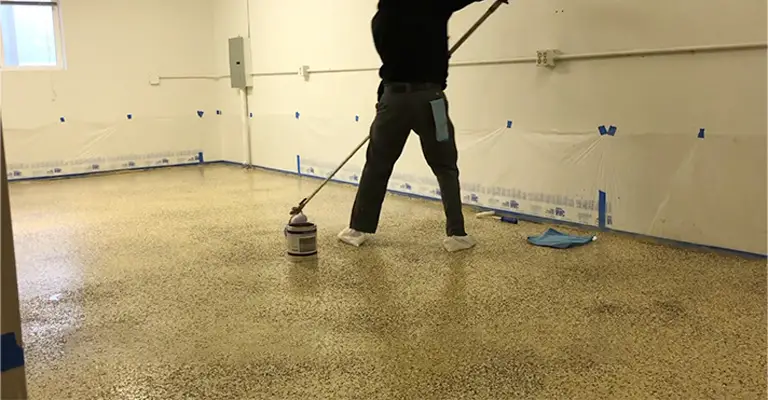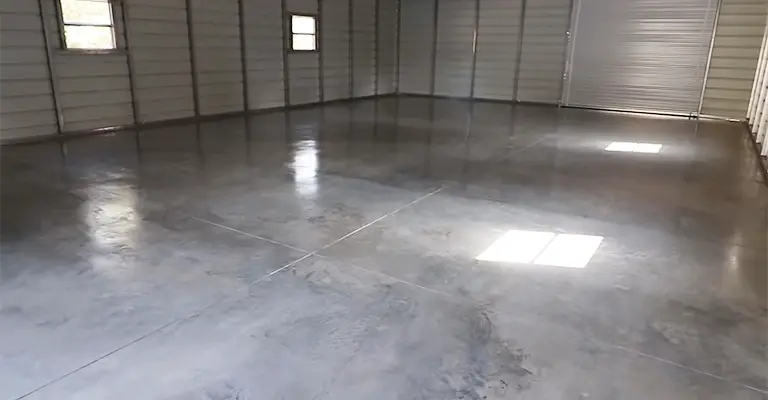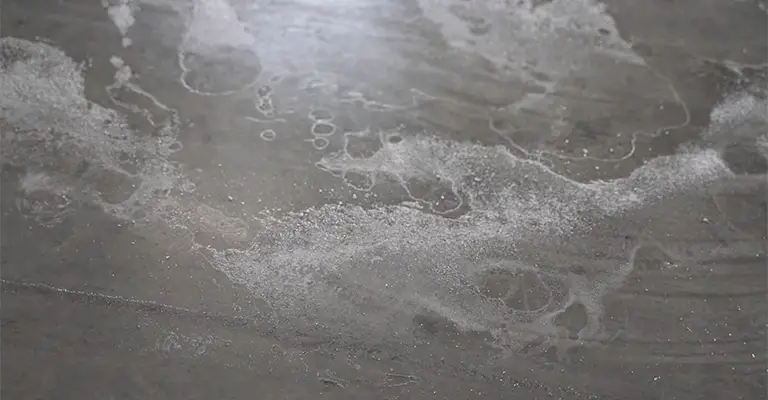Dealing with concrete sweating can be frustrating, especially in environments with high humidity.
The accumulation of moisture on concrete surfaces can lead to various issues. Fortunately, you can employ several practical strategies to prevent or minimize concrete sweating.
Concrete “sweating,” also known as condensation or moisture accumulation on the surface of concrete, usually occurs when warm, humid air comes into contact with a cooler concrete surface.
This is a common issue in areas with high humidity levels.
How To Stop Concrete Floor Sweating?

Air movement is the best way to dry the room: a low-speed, high-volume fan will work. Keeping the concrete floor and air at the same temperature means turning down the air conditioning and turning up the heat.
Make sure the air is dry, and that condensation doesn’t occur. Make sure the concrete is sealed with a penetrating sealer. We recommend a concrete densifier followed by a penetrating concrete sealer for primer.
Make sure to use a penetrating concrete sealer as soon as possible so that mold or mildew doesn’t develop on your concrete.
You should use a chemically reactive concrete densifier and then apply an impregnating, penetrating sealer to stop concrete sweating.
Here are some other steps you can take to help prevent or mitigate concrete sweating:
1. Improve Ventilation
Ensure that the space where the concrete is located has proper ventilation. Good airflow helps reduce humidity levels and prevents moisture buildup on the surface of the concrete.
2. Insulation
If the concrete is in contact with a cooler surface, such as a basement wall, insulating the surface can help prevent temperature differences that lead to condensation. Insulation can keep the surface warmer, reducing the potential for sweating.
3. Dehumidification
Use a dehumidifier in the area to lower the humidity levels. This can significantly reduce the moisture content in the air and prevent condensation on the concrete.
4. Sealants and Waterproofing
Apply appropriate sealants or waterproofing products to the concrete surface. These products create a barrier that can help prevent moisture from penetrating the concrete, reducing the chances of sweating.
5. Proper Grading and Drainage
Ensure that the surrounding area is appropriately graded and has adequate drainage. This prevents water from pooling around the concrete, which can contribute to higher humidity levels.
6. Heating
Maintaining a consistent temperature in the area can help prevent temperature differentials that lead to condensation. Heating the space, especially during periods of high humidity, can reduce the likelihood of sweating.
7. Use of Fans
Circulating air with fans can help maintain consistent temperatures and reduce the chances of condensation forming on the concrete surface.
8. Absorbent Materials
Place absorbent materials like towels or mats on the concrete surface to catch any accumulated moisture. Regularly changing and drying these materials can help prevent sweating.
9. Air Conditioning
If possible, use air conditioning to control the temperature and humidity levels in the area. Air conditioning helps to remove excess moisture from the air.
10. Design Considerations
In new construction or renovation projects, design considerations such as vapor barriers and proper insulation can be implemented to prevent condensation issues from occurring.
What Causes New Concrete To Sweat?
An interior concrete slab can get sweating slab syndrome when moisture forms intermittently on the surface. Concrete sweating happens when warm air directs moisture toward a colder concrete slab.
In addition, concrete sweats when there’s a combination of high temperatures and humidity. When a floor slab’s surface is colder than the air temperature above it, moisture will condense on the slab.
It’s common when warm, moist air flows into buildings with relatively cool floors, causing sweating.
Why Is Concrete Sweating Problematic?

Concrete sweating can be dangerous if there’s a lot of traffic on cement slabs. Using concrete sweat has a few dangers, which we’ll discuss below.
Slippery
Slipping is the most common concrete sweat issue. Combining water droplets with a smooth concrete floor is dangerous. I don’t think you’d want to walk on that concrete if it’s sealed.
Getting wet on any smooth, hard surface is a risk. However, a sealed surface is different. Moisture can’t get into the concrete because the sealant gets into the pores. It stays on the surface as moisture can’t seep into the pores.
There’s no need to use much water on concrete to make it slick. The tiniest bit of water can make you fall.
Mold
Getting a mold infection could also be very dangerous for your health. You can get mold growth on wet concrete surfaces, especially indoors if it’s warm.
Taking in mold toxins can cause allergies and some diseases.
You should avoid any condition that supports mold growth. A sweaty slab is a perfect breeding ground for mold.
The building industry promotes tightening of the “building envelope” to make it more energy efficient. However, that means fighting mold more often. Maintaining concrete’s dryness and preventing mold is essential.
Alkali
An alkali-silica reaction (ASR) happens when concrete swells over a duration of time. This is caused by the highly alkaline cement paste and the reactive amorphous found in many common aggregates.
In the presence of sufficient moisture, these substances react. The concrete can be permanently damaged if subsurface moisture has a high pH and seeps through.
In concrete, ASR can cause serious cracking, leading to structural problems. A crack in a building can cause unsafe conditions and failure.
Under concrete slabs, you should install a vapor barrier. A gap in the barrier can let moisture from the ground get into the concrete.
Groundwater can also seep through cracks in the slab and puddle on the floor if there are cracks. Because of this, moisture barriers and proper drainage are so important.
When groundwater runs through a concrete floor slab, it can carry alkalis. It can damage the concrete permanently over time from an alkali attack. It can lead to damage, expensive repairs, and sometimes the collapse of structural concrete.
Efflorescence
Garage floors can look darker after getting wet due to moisture content, and they can even get efflorescence.
As concrete absorbs water, it evaporates, leaving behind white mineral deposits on the surface. As moisture travels through concrete, those minerals get carried along.
Efflorescence isn’t harmful to concrete, but it means your concrete is sweating. Some masons believe efflorescence weakens concrete over time by extracting minerals from it.
Although I’ve never seen efflorescence affect concrete slabs or foundations, it’s still a bad sign and should be dealt with if it happens.
How To Spot A Moisture Condition On A Concrete Floor?
Transmitting moisture vapor can cause significant expenses, repairs, and even loss of revenue.
Although your concrete floor may look fine, there are a few things to check, keeping in mind that the sooner you find out there’s moisture in the building, the quicker you can fix it.
What about damp spots or discoloration on the concrete? There might be moisture under the slab.
- Have you noticed any cracks in the concrete?
- Have you seen a white residue on your concrete slab? If so, your concrete floor might have alkali/salt deposits from condensation.
- Do you smell must in your building, mold growing, or mildew?
- Is there anything black on the bottom of the walls, machines, or inventory?
- Does your building have an unusually moist climate?
- How can you prevent concrete slabs from sweating and having excess moisture content?
The Bottom Line
Concrete sweating can be prevented by using a penetrating sealer to seal the concrete and keep the moisture out.
First, use a concrete densifier as a primer and a penetrating water repellent. Also, penetrating concrete sealers keep mold and mildew from growing if the concrete sweats.








